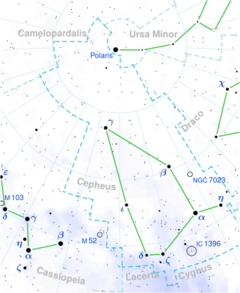Astronomy:HD 1
Coordinates: ![]() 00h 05m 08.84054s, +67° 50′ 23.9805″
00h 05m 08.84054s, +67° 50′ 23.9805″
| Observation data Equinox J2000.0]] (ICRS) | |
|---|---|
| Constellation | Cepheus |
| Right ascension | 00h 05m 08.84054s[1] |
| Declination | +67° 50′ 23.9805″[1] |
| Apparent magnitude (V) | 7.42±0.01[2] |
| Characteristics | |
| Evolutionary stage | red giant branch[1][3] |
| Spectral type | G9-K0 IIIa[3] |
| Astrometry | |
| Radial velocity (Rv) | −27.3±0.5[4] km/s |
| Proper motion (μ) | RA: +7.480[1] mas/yr Dec.: −5.045[1] mas/yr |
| Parallax (π) | 2.668 ± 0.0485[1] mas |
| Distance | 1,220 ± 20 ly (375 ± 7 pc) |
| Absolute magnitude (MV) | −0.01[5] |
| Orbit[6] | |
| Period (P) | 6.345±0.007 yr |
| Eccentricity (e) | 0.488±0.013 |
| Periastron epoch (T) | 2,452,213±9 JD |
| Argument of periastron (ω) (secondary) | 224±2.2° |
| Semi-amplitude (K1) (primary) | 4.35±0.08 km/s |
| Details | |
| Mass | 3.0[3] M☉ |
| Radius | 30[7] R☉ |
| Luminosity | 226±5[4] L☉ |
| Surface gravity (log g) | 1.81[8] cgs |
| Temperature | 5,844±122[9] K |
| Metallicity [Fe/H] | +0.24[8] dex |
| Rotational velocity (v sin i) | 5.6±1.2[3] km/s |
| Age | 350[3] Myr |
| Other designations | |
| Database references | |
| SIMBAD | data |
HD 1, also known as HIP 422, is the first star catalogued in the Henry Draper Catalogue. It is located in the northern circumpolar constellation Cepheus and has an apparent magnitude of 7.42,[2] making it readily visible in binoculars, but not to the naked eye. The object is located relatively far away at a distance of 1,220 light years but is approaching the Solar System with a spectroscopic radial velocity of −27.3 km/s.[4]
Characteristics
Originally thought to be a single object, observations from Griffin & McClure (2009) reveal it to be a single-lined spectroscopic binary. The components take approximately 6 years to circle each other in an eccentric orbit.[6] The visible component is an evolved red giant branch[1] (RGB) star with a stellar classification of G9-K0 IIIa,[3] a spectral class intermediate between a G9 and K0 giant star. It has 3 times the mass of the Sun, but at the age of 350 million years[3] it has expanded to 30 times its girth.[7] It radiates 226 times the luminosity of the Sun[4] from its enlarged photosphere at an effective temperature of 5,844 K,[9] giving it a yellowish-orange hue. HD 1A is metal enriched, with an iron abundance 74% above solar levels.[8] The objects spins modestly with a projected rotational velocity of 5.6 km/s.[3]
References
- ↑ 1.0 1.1 1.2 1.3 1.4 1.5 Vallenari, A. et al. (2022). "Gaia Data Release 3. Summary of the content and survey properties". Astronomy & Astrophysics. doi:10.1051/0004-6361/202243940 Gaia DR3 record for this source at VizieR.
- ↑ 2.0 2.1 Høg, E.; Fabricius, C.; Makarov, V. V.; Urban, S.; Corbin, T.; Wycoff, G.; Bastian, U.; Schwekendiek, P. et al. (March 2000). "The Tycho-2 catalogue of the 2.5 million brightest stars". Astronomy and Astrophysics 355: L27–L30. ISSN 0004-6361. Bibcode: 2000A&A...355L..27H.
- ↑ 3.0 3.1 3.2 3.3 3.4 3.5 3.6 3.7 Strassmeier, K.G.; Weber, M.; Granzer, T.; Dall, T.H. (20 April 2010). "HD 1: The number-one star in the sky". Astronomische Nachrichten 331 (4): 368–377. doi:10.1002/asna.201011356. ISSN 0004-6337. Bibcode: 2010AN....331..368S.
- ↑ 4.0 4.1 4.2 4.3 Brown, A. G. A. (August 2018). "Gaia Data Release 2: Summary of the contents and survey properties". Astronomy & Astrophysics 616: A1. doi:10.1051/0004-6361/201833051. Bibcode: 2018A&A...616A...1G. Gaia DR2 record for this source at VizieR.
- ↑ Anderson, E.; Francis, Ch. (May 2012). "XHIP: An extended hipparcos compilation". Astronomy Letters 38 (5): 331–346. doi:10.1134/S1063773712050015. ISSN 1063-7737. Bibcode: 2012AstL...38..331A.
- ↑ 6.0 6.1 Griffin, R. F.; McClure, R. D. (February 2009). "Spectroscopic binary orbits for the Henry Draper Catalogue stars". The Observatory 129: 28–32. ISSN 0029-7704. Bibcode: 2009Obs...129...28G.
- ↑ 7.0 7.1 Kervella, Pierre; Arenou, Frédéric; Thévenin, Frédéric (2022). "Stellar and substellar companions from Gaia EDR3". Astronomy & Astrophysics 657: A7. doi:10.1051/0004-6361/202142146. ISSN 0004-6361. Bibcode: 2022A&A...657A...7K.
- ↑ 8.0 8.1 8.2 Anders, F. et al. (August 2019). "Photo-astrometric distances, extinctions, and astrophysical parameters for Gaia DR2 stars brighter than G = 18". Astronomy & Astrophysics 628: A94. doi:10.1051/0004-6361/201935765. ISSN 0004-6361. Bibcode: 2019A&A...628A..94A.
- ↑ 9.0 9.1 Stassun, Keivan G. et al. (9 September 2019). "The Revised TESS Input Catalog and Candidate Target List". The Astronomical Journal 158 (4): 138. doi:10.3847/1538-3881/ab3467. Bibcode: 2019AJ....158..138S.
- ↑ "HD 1". SIMBAD. Centre de données astronomiques de Strasbourg. http://simbad.u-strasbg.fr/simbad/sim-basic?Ident=HD+1.
 |


